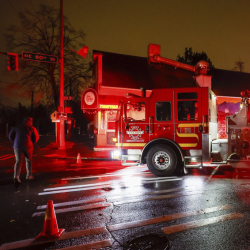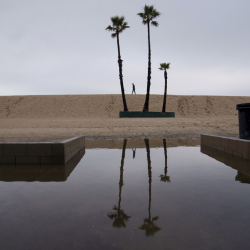 WASHINGTON (NNPA) - Four years have passed since the country's most devastating hurricane almost washed away New Orleans and its neighbors. Highlighted by the president's recent visit to the Gulf Coast, the city is slowly recovering. But residents closer to retirement age are having a more difficult time than most getting back on their feet.
WASHINGTON (NNPA) - Four years have passed since the country's most devastating hurricane almost washed away New Orleans and its neighbors. Highlighted by the president's recent visit to the Gulf Coast, the city is slowly recovering. But residents closer to retirement age are having a more difficult time than most getting back on their feet.
Nestled between the big mansions of uptown and the tourist-heavy French Quarter is New Orleans' Hollygrove neighborhood. The historic 17th Ward community is 98 percent African-American and has a heavy 50-plus population. About 7,000 residents lived in Hollygrove before the storm according to the 2000 U.S. Census. It is now about 67 percent repopulated.
Photo courtesy Sean Cruz (2007)
Lifelong Hollygrove resident Earl Williams came back after he lost his home in the storm. It was completely demolished. Now, he has been rebuilding it from ground up. He is left to do the general contracting himself.
"The Louisiana Road Home program has been a challenge for a lot of people," said Williams about the government's homeowner and small rental property repair program. The Road Home program provides up to $150,000 compensation to Louisiana homeowners affected by Hurricanes Katrina or Rita for the damage to their homes.
"The elderly, in particular, have been having a very difficult time recovering. A number have died right after Katrina, including my mom," the 54-year-old former business owner said. "There was a period of five or six months people when people were just...dying. A lot of it was due to the stress and the trauma of Katrina. It was the not only the stress of losing everything but also having to rebuild everything, losing loved ones, just a lot of psychological scars."
Three years ago, the country's biggest senior lobby, AARP, wanted to focus on a neglected New Orleans neighborhood that had a high 50-plus population and be the
on-ground support for recovery.
"Hollygrove was one of the forgotten neighborhoods in the recovery process," said Jason Tutor, AARP's Hollygrove project manager.
The relationship was born out of a leadership academy to train community leaders in the neighborhood. It grew into a two-year intense project to make communities livable. It was made possible by a $230,000 project from the Harris Foundation.
The project focused on health and care giving, transportation and mobility, public safety resident engagement and economic development.
But there were major issues.
"Crime was a big problem," says AARP Louisana communications director Beth Bryant of some of the issues that older residents face during recovery. "There are still a lot of vacancies, seniors are still caregivers to kids of displaced parents, public transportation is still a problem, inaccessibility to grocery stores and health clinics...there is still a lot of work to be done."
One of the biggest issues that older people are facing is contractor fraud and access to Road Home money, says Bryant.
"The Obama Administration is providing assistance, including loans and grants, through a variety of public, private and non-profit sources to help seniors meet their housing needs," said White House spokesperson Corey Ealons.
Last month, HUD Secretary Donovan announced approval of additional Road Home funds to help people who are struggling to rebuild their homes. This additional grant program could distribute $600 million in leftover program money, giving up to $34,000 in extra grant money to as many as 19,000 low- to moderate-income homeowners. Applicants who depended solely on Road Home grants were predominately low-income and African-American.
"We're sort of past the federal thing," Bryant said. "The federal government's responsibility was disaster response and we all know how that went. Now, it's pretty much in the hands of municipalities. So what we are dealing with is trying to encourage the municipal governments to work with the citizens and the residents of neighborhoods so that they can have a say on how their community recovers. We don't see a lot of that. We don't see a lot of public process in place."
Obama's recovery act was supposed to cut the bureaucratic red tape that has notoriously held up the fund disbursement process. But residents say that it is doing nothing because the federal money goes through the city.
And the local government has its own bureaucracy. The process has been complicated by the myriad of city departments that have come up and have since dissolved.
"The city is doing things to the communities. They are not doing anything with the communities," Tutor said. "We have all of these recovery projects going on that have zero to very little input from the community. The problem is there is no centralized system for a resident, a senior who has issues in their neighborhood to go to."
You can go through the neighborhoods and see the difference between those who had insurance and those who didn't, Bryant said. Those who had insurance got money immediately. Those who didn't have insurance had to wade through the morass of bureaucracy to get access to Road Home funds.
There seems to be some inequity in the priority of rebuilding.
"The tourist part of New Orleans seems to be fine. The city looks great as far as the touristy areas. If you're a tourist you probably wouldn't notice," Bryant said.
But historic African-American community landmarks are being demolished and re-purposed into other types of properties. The group is currently fighting against the city's plans to tear down a senior center.
"Why aren't our senior voices being heard in a city that is so dependent on our heritage and our culture for our tourism reasons and for the whole basis of our economy, which is based on our culture and heritage," Tutor said. "Our African-American culture and heritage is being destroyed in New Orleans and no one is listening or paying attention."
Representatives from the city of New Orleans failed to return our request for comment.
One of the problems the Hollygrove residents is still experiencing is repetitive flooding that happens regardless of hurricanes because of a drainage canal in the back of the neighborhood that the city has not addressed.
The Monticello canal is what separates the affluent Jefferson Parish from the more humble Orleans Parish. Jefferson Parish has eight-foot levees, whereas Orleans Parish has no levee. So when water rises in that canal it floods Hollygrove every time.
A low-income African-American community called Hollygrove is being negatively affected by a levee system that is protecting another more affluent and privileged community that is home to the majority of New Orleans' suburbs.
Tutor quizzes, "Is it coincidence that the wealthiest neighborhood in Louisiana is also on the other side of that levee? Is it coincidence that the wealthiest neighborhood in Louisiana is majority White? Without pulling a race card, I don't know."






















































































































































































































































































































































